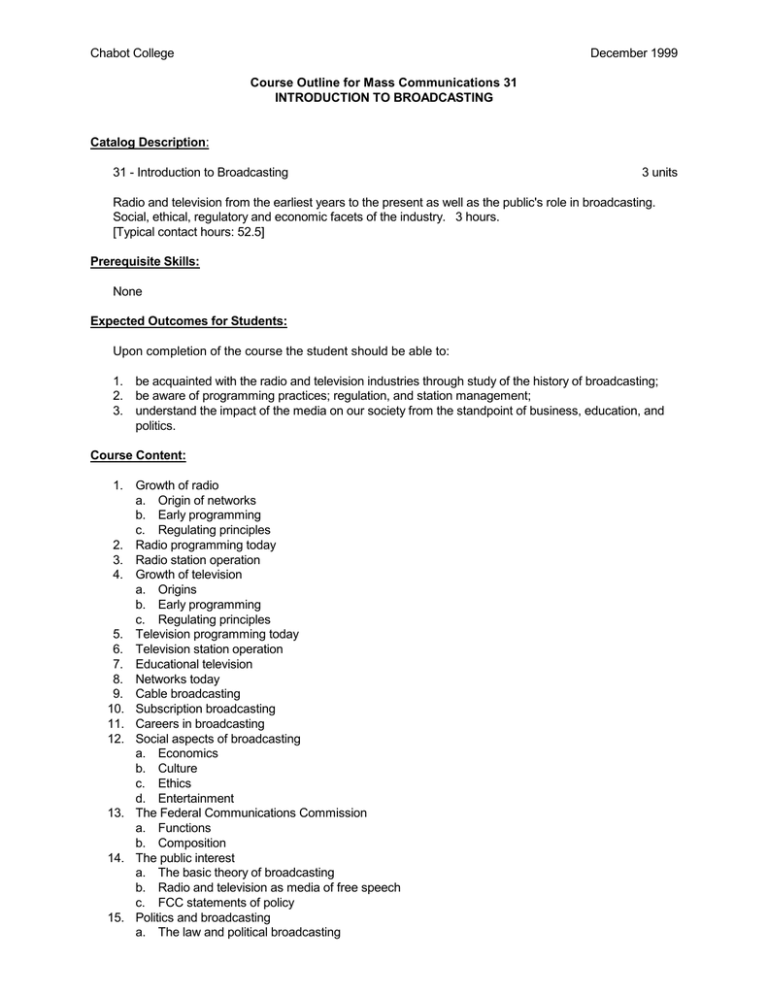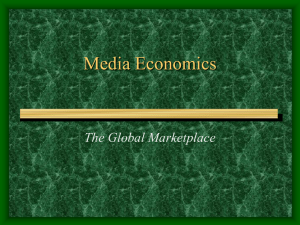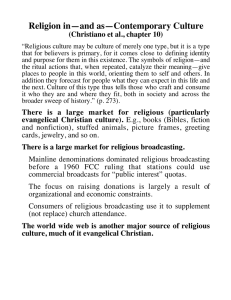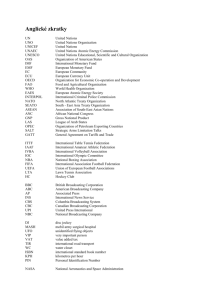Chabot College December 1999 31 - Introduction to Broadcasting
advertisement

Chabot College December 1999 Course Outline for Mass Communications 31 INTRODUCTION TO BROADCASTING Catalog Description: 31 - Introduction to Broadcasting 3 units Radio and television from the earliest years to the present as well as the public's role in broadcasting. Social, ethical, regulatory and economic facets of the industry. 3 hours. [Typical contact hours: 52.5] Prerequisite Skills: None Expected Outcomes for Students: Upon completion of the course the student should be able to: 1. be acquainted with the radio and television industries through study of the history of broadcasting; 2. be aware of programming practices; regulation, and station management; 3. understand the impact of the media on our society from the standpoint of business, education, and politics. Course Content: 1. Growth of radio a. Origin of networks b. Early programming c. Regulating principles 2. Radio programming today 3. Radio station operation 4. Growth of television a. Origins b. Early programming c. Regulating principles 5. Television programming today 6. Television station operation 7. Educational television 8. Networks today 9. Cable broadcasting 10. Subscription broadcasting 11. Careers in broadcasting 12. Social aspects of broadcasting a. Economics b. Culture c. Ethics d. Entertainment 13. The Federal Communications Commission a. Functions b. Composition 14. The public interest a. The basic theory of broadcasting b. Radio and television as media of free speech c. FCC statements of policy 15. Politics and broadcasting a. The law and political broadcasting Chabot College Course Outline for Mass Communications 31, Page 2 December 1999 b. Coverage of political events 16. The economics of broadcasting a. Advertising and agencies b. Problems posed by advertising c. The audience 1. Research and surveys 2. Ratings - how they are attained and what they mean 17. Comparative broadcast systems a. Types of systems b. Radio and television in Great Britain c. Radio and television in Canada d. Other systems e. Growth of international broadcasting 1. Radio and World War II 2. International broadcasting since World War II 3. Communications satellites Methods of Presentation: 1. 2. 3. 4. 5. 6. Lecture Discussion Student presentations Audio-visual aids Homework assignments Research project Assignments and Methods of Evaluating Student Progress: 1. Typical Assignments a. Oral presentations of group research and discussion b. Written definition of ethics and explanation of their individual ethics c. Written analysis of ethical issues presented in a video d. Primary and secondary research term paper e. Oral report on term paper 2. Methods of Evaluating Student Progress a. Class participation in analyzing topics of discussion based on instructor observation of the extent to which students apply the techniques of media analysis b. Quality of research c. Quality of verbal presentations d. Written tests e. Final exam Textbook(s) (Typical): Telecommunications: An Introduction to Electronic Media, Lynne S. Gross, Wm. C. Brown Co., 2000 Special Student Materials: None dk 01/14/00 D:\LAH\CURRICUL\FALL99\MC31_REV.DOC




